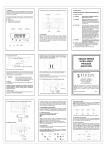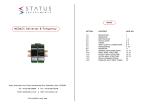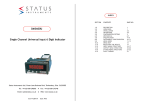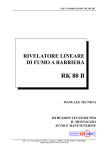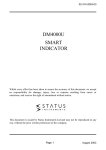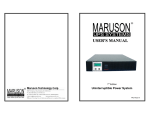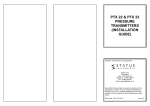Download User Guide - DM3430 Series
Transcript
1.0 GENERAL The diagram shows the rear panel positions for all electrical connections. The unit is a highly accurate and stable digital indicator for displaying AC/DC current or voltage in true RMS. The unit can be used "stand alone" or, with the Modbus serial communications pod option, as part of a larger system. THIS SECTION FOR USE BY COMPETENT PERSONNEL ONLY OPTION POD SLOT 2 (NOT SHOWN) 3.1 Safety Information OPTION POD SLOT 1 The case design enables option Pods to be easily installed without the need for dismantling or re-calibration. A range of Pods are available for: Relay outputs Isolated 4-20 mA re-transmission Modbus serial communication. FRONT PANEL SEALED TO IP65 3.0 INSTALLATION WARNING READ SAFETY INFORMATION BELOW BEFORE INSTALLATION WARNING Hazardous voltages may be present on the terminals - the equipment must be installed by suitably qualified personnel and mounted in an enclosure providing protection to at least IP20. ISOLATION BRIGHT FOUR DIGIT DISPLAY The power supply terminals and associated internal circuitry are isolated from all other parts of the equipment in accordance with BS EN61010-1 for connection to a Category II supply (pollution degree 2) Functional isolation (3.5kv max) is provided between input and output circuits, and between inputs and communications (where fitted). DISCRETE LED ALARM INDICATORS VOLT/CURRENT INPUT POWER CONNECTOR Any terminals or wiring connected to the input, output or communications terminals which are accessible in normal operation must ONLY be connected to signals complying with the requirements for Safety extra low voltage (SELV) circuits. 2.0 UNPACKING 1 2 V ac CYCLE KEY SHIFT KEY INCREMENT KEY 3 4 Tag No. Please inspect the instrument carefully for any signs of shipping damage. The packaging has been designed to afford maximum protection, however, we cannot guarantee that mishandling will not have damaged the instrument. In the case of this unlikely event, please contact your supplier immediately and retain the packaging for subsequent inspection. LEGEND WINDOW 3.2 Installing Into a Panel WARNING If not installed in accordance with these instructions, protection against electrical hazards may be impaired. Installation overvoltage category - 2 (as per BS EN61010-1) The Mains supply to the equipment must be protected by an external 1 Amp fuse and a suitable switch or circuit breaker which should be near the equipment. The equipment contains no user serviceable parts. The indicator must be panel mounted into a suitable enclosure, with at least IP20 protection behind panel. 3.4 Power Supply The Power supply rating will be indicated on the top of the instrument, ensure it is correct for the application. 140.0 10 mm MAX PANEL THICKNESS DM3430 TRUE RMS INDICATOR The Mains supply to the equipment must be protected by an external 1 Amp fuse and a suitable switch or circuit breaker which should be near the equipment. OPTION POD Wires are retained by screws. Ensure that the exposed section of the wire is fully inserted and that no loose strands are exposed. CLAMPING SCREW PANEL CLAMP Cutout 92.0/92.8 x 45.0/45.6 mm (DIN 43700) Refer to section 8.0 for Mechanical Detail. Designed, manufactured and supported by : The maximum panel thickness is 10mm. The instrument case has an integral gasket which forms a seal when the instrument is tightened against the panel. The panel should be clean, smooth and at least 1.6mm thick for the seal to be effective. WARNING (+) L Use only the retaining screws provided to clamp the instrument to the panel (screws must be tightened sufficiently to effect a seal but must never be overtightened). N (-) Green Lane. Tewkesbury. Gloucestershire. GL20 8DE. UK Tel : 01684 296818. Fax : 01684 293746. Email: [email protected] Web: www.status.co.uk 3.3 Wiring All connections are made to sockets which are removable for ease of maintenance. To minimise potential noise problems, power the indicator from the same power branch or phase as that at the signal source. Every effort has been taken to ensure the accuracy of this specification, however we do not accept responsibility for damage, injury, loss or expense resulting from errors and omissions, and we reserve the right of amendment without notice. Installation should be undertaken in accordance with relevant sections of BS6739 - British Standards code of practice for "Instrumentation in Process Control Systems: Installation design and practice". 3.5 Input Connections All input connections are made via the eight way socket at the rear of the unit (wire size 0 to 2.5mm²). Isolation The input is isolated by 3500V from the indicator circuitry and from the output options. 3.5.1 Voltage and Current Measurement Stock code : 52-314-2317-01 4.0 PROGRAMMING THE INSTRUMENT The unit is a microprocessor based instrument enabling it to satisfy a variety of applications. All programming is available from the front panel or via a PC using the RS485 Modbus communications pod. - + 6A 60V 550V - SLt1 * INPUT 4.2 Key Definitions All programming is done using the three front panel keys, A,B and C are shown to assist the tutorial. SLt2 * OUTPUT SUBMENU EDIT mode is entered from Menu Mode and allows the user to inspect and modify a parameter. SYS OUTPUT SYSTEM POD 1 POD 2 SUBMENU SUBMENU SUBMENU * Slot menus only appear when respective option pods are fitted. 4.3.1 Moving Around The Menu You can browse through the Root menu by pressing CYCLE (A) which moves the menu position from left to right (after reaching SYS, the menu position wraps around to the start). 4.3.2 Entering A Submenu To enter a submenu, first cycle around the Root menu until the required submenu is displayed. For the purposes of this tutorial press the CYCLE (A) key until InPt is displayed. Pressing SHIFT (B) enters the Input Submenu. CYCLE (A), SHIFT (B) and INC (C) keys are pressed singularly. tYPe will now be displayed. The diagram shows our position in relation to other items in the menu. ESCAPE (A&B), ENTER (B&C) and CLEAR (A&C) are obtained by simultaneously pressing the two keys. Pressing CYCLE (A) moves left to right, wrapping around at the end. The unit alters items in the menu list depending upon settings made. Connect only one input at any time to the indicator. Wherever possible connect the neutral side or circuit common to the input terminal. inPt ESCAPE CYCLE A A B ENTER SHIFT Ensure power is disconnected prior to wiring. ROOT MENU inPt The unit has three operating modes. These are :RUN (DISPLAYS PROCESS VARIABLE) MENU EDIT MENU mode provides access to the programmable parameters. + 4.3 Entering Menu Mode The Root Menu mode is accessed from "Run" by pressing ENTER (B&C) followed by CYCLE (A). The display will now show "inPt". In order to understand what this means, the following diagram shows where we are within the basic Root menu. 4.1 Programming Guide RUN is the principal mode of operation, which displays the Process Variable from which all other modes are accessed. The unit will always time-out back to this mode after one minute. + Issue: 1 B B dP SCAL Short Menu CLEAR INC C tYPE C A C FILt Full Menu ACDC 4.3.3 Editing A Parameter The items displayed in the menu can either be submenus, parameters or numbers, most of the items in the Inputs menu are parameters which can be edited. Press the CYCLE (A) key until tYPe is displayed, then press SHIFT (B). The current setting will now be shown flashing. This item is changed by pressing the INC (C) key. The Root menu, as its name suggests is not a submenu. Pressing the ESCAPE (A&B) key sequence whilst in the Root menu will take the user out of Menu mode and into Run mode. Thus the process variable will be shown on the display. 5.0 OPERATION 5.1 Run Mode Operation Refer to section 5.2 if an error code is shown after programming in menu mode. KEYPRESS CYCLE (A) 4.4 The Menus 4.4.1 The INPt (INPUT) Submenu The INPt submenu is used to program all the characteristics of the input sensor and any signal conditioning that may be required. The selection of an option in the list may affect items further down. Therefore, during programming, the user should start at the top of the menu and work down, to avoid setting an option which may later become obsolete. Short menu only items shown in bold. The choice of options available is as follows: inPt tYPE The normal display shown in this mode is the process variable. ACTION View setpoints (Adjust value if SPEn enabled) Reset relay latch and peak-valley (cLEn enabled) View peak memory View valley memory CLEAR (A&C) SHIFT (B) INC (C) 6.0 SPECIFICATION @20 ºC Waveform Type 1V Peak Crest Factor (V Peak/ V RMS) True RMS Value Mean Value Calibrated to % Error in Mean circuit* read RMS 60V 550V 6A Press the INC (C) key until "60V" is displayed. Note that whilst the display is flashing, the option on the display has not been saved to memory. To select an option, the ENTER key sequence is used. Press ENTER (B&C). The display will stop flashing momentarily before returning to Menu mode. The system automatically steps on to the next entry to speed the process of programming. This method of editing parameters is repeated throughout the menu structure. 4.3.4 Returning From Submenus To return up from the inPt menu to the root menu wait for 1 minute or press the ESCAPE (A&B) key. Pressing the ESCAPE key from our current position in the Inputs submenu takes us back to the Root menu. The menu position will automatically step to the next menu item, if no pods are fitted the unit will show SYS, if pods are fitted SLt1 or SLt2 will be shown. 6.2 General Specification @ 20 ºC Input/Output Isolation Update time Time Constant (Filter off) Filter Factor Warm-up time Display Range Power Supply Power Consumption Supply Isolation S1 S2 Environmental Sealing to PANEL Ambient Operating Range Ambient Storage Temperature Ambient Humidity Range Approvals EMC Electrical Safety Emissions Susceptibility 3.5KV rms (galvanically isolated) 250 mS maximum <1 second (to 63% of final value) Off, 2 Seconds, 10 Seconds or Adaptive 2 minutes to full accuracy -999 to 9999 90-253 VAC 50/60 Hz 20-35 VDC; 24Vac ±10% 6VA Maximum (options fitted) 3.5KV IP65 -30 to +60 ºC -50 to +85 ºC 10 to 90% RH non condensing BS EN50081-1 pending BS EN50082-2 pending BS EN61010-1 pending UL pending Environmental Approvals for Tension Clamp Terminals Low Temperature IEC 68-2-1 Dry Heat IEC 512-6-9 Damp Heat IEC 512 -6-3 Damp Heat cyclical IEC 68-2-30 Salt Spray IEC 512-6-6 Sulphur Dioxide IEC 68-2-46 Hydrogen Sulphide IEC 68-2-16 Gas Tightness IEC 512-Pr.11n 7.0 OPTION PODS OPTIONS 60V, 550V, 6A 888.8, 88.88, 8.888, 8888 User defined scale AC, DC nonE, 2.5, 10.5, Adaptive TITLE tYPE dP ScAL ACDC FiLt DETAIL Input Type selection Defines decimal point location Multiplying factor applied to input AC / DC Selector Input Filtering or smoothing 1.41. 0.707 0.707 0% 1 1 1.11 0.5% Pure Triangle Wave 1.73 0.577 0.555 0.5% SCR Waveforms 50% Duty Cycle 2 0.495 0.354 25% Duty Cycle 4.7 0.212 0.15 2.2% 4.4.2 The SyS (System) Submenu 6.1 Input Specification TITLE LiSt cLEn SPEn AdEL PASS oFFS Accuracy ±0.1%FSD Thermal Drift Input Impedance OPTIONS FuLL, SHrt oFF, on oFF, on oFF,2,5,10,20,60,120,240 4 digit passcode User defined offset DETAIL Selects full or short menu Clear enable (option pods) Setpoint enable (option pods) Power-up alarm delay Modify any password code Take care when replacing sensor 0.1% of rdg/ 0.02% / ºC 10mW 1mW 0.02W 3.5KV ±550Vdc ; 550Vac ±60Vdc ; 60Vac ±5A ; 5Aac 550V 60V 6A Isolation Ranges Refer to section 7.0 for SLt menu structures. To install an option pod, slide back the cover to its next engaging position and push the pod connection within the mating connector. To remove an option pod, disengage the supporting latch situated beneath the pod by pushing the back cover forward, the pod can then be lifted away from the instrument connector. 7.1 Dual Relay Pod. POD-3000/02 The relay pod has two "change over" relays with a common wiper. 1 2 3 4 NC = NO = 5 Normally closed Normally open 7.1.2 Relay Specification AC DC Maximum Load 7A @ 250V 7A @ 30V Maximum Power 1750VA 210W Maximum Switching 250V 125V Electrical Life 105 operations at rated load Mechanical Life 50 Million operations 7.2 Isolated 4-20mA Re-transmission Pod. POD-3000/03 The re-transmission pod (when fitted) is designed to provide 0-10mA, 0-20mA or 4-20mA output in active or passive modes. The output can be any portion of the display. The pod can be used in two modes: Active (Source) Passive (Sink) - 7.1.1 SLT1, SLT2 (Relay Pod) Submenu R Load V + R Load Each relay can be set as high or low alarm independently. TITLE AL 1 SEt1 dEL1 HYS1 LAt1 inUI OPTIONS Hi, Lo User defined off, 2, 5, 10, 20, 60, 120, 240 User defined oFF, on oFF, on DETAIL Alarm action PV at which the alarm triggers Alarm delay Hysterisis band (see below) Sets latching to on or off Invert relay operation Continues through for Relays 2 - 4 (when fitted). Hysteresis Operation HIGH ALARM Setpoint Hysteresis Band 7.0.1 Installing Pods Power must be removed from unit before adding/removing a pod. Slot 1 (alarm 1 and 2) should be positioned on the left side of the unit looking from the front to correspond to front panel alarm indicator, slot 2 (alarm 3 and 4) is positioned on the right. Alarm State LOW ALARM Setpoint 1 2 Hysteresis Band Minimum Current Output Maximum Current Output Accuracy Maximum External Power Supply Voltage Effect Ripple Current Isolation Temperature Stability Configuration, system I/O and display unit PC communication. Physical Layer 4 wire or 2 wire half duplex RS485 Isolation 500V AC Maximum Fan out 32 units Software Baud Rate 19,200 or 9,600 Protocol Modbus RTU format 3 1 3 4 5 RLoad < (V-2) K Ohm 22 And Vmax = 30V TITLE SPan rt lo rt HI OPTIONS 4-20mA, 0-20mA, 0-10mA User defined User defined DETAIL User defined output current Low span range, to match display High span range, to match display 96.0 1 4 2 7.2.1 SLT1, SLT2 (Re-transmission Pod) Submenu Ribbon cable connection version 2 5 Only one Re-transmission pod can be fitted. * Optional link 1 4 Alarm State 7.3.2 Comms Pod Specification 7.3 Modbus Serial Communications Pod. POD-3000/05 The diagram below shows a PC connected to Modbus pods. 3 Max RLoad = 1K Note: 7.2.2 Re-Transmission Pod Specification > 0mA < 23mA 0.07% or 5µA, which ever is greater 30V (passive mode) 0.2µA / V <3µA 500V AC 1µA / ºC Pure Sine Wave Symmetrical Square Wave 2 V ac 5 3 4 48.0 Tag No. Modbus link 11.0 131.0 BEHIND BEZEL * Optional link Device 1 Device 2 Device 3 LINK, Device 4 7.3.1 SLT1, SLT2 (Communications) Submenu TITLE Addr baud Line OPTIONS User defined 9.6, 19.2 2, 4 DETAIL Instrument device number User selected baud rate 4 Wire or 2 wire half duplex RS 485 * Connection of the link connects a 100 ohm termination resistor across pins 7 and 8. This resistor should only be selected for the instrument furthest away from the host. Full details of the modbus protocol are supplied separately with the pod. 8.0 MECHANICAL DETAIL Material Weight Flammability Pod weight Panel cutout ABS/PC 200g IEC707 FV0 40g typical 92mm x 45mm Stock code : 52-314-2317-01, Issue: 1


